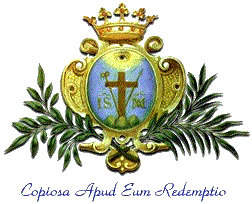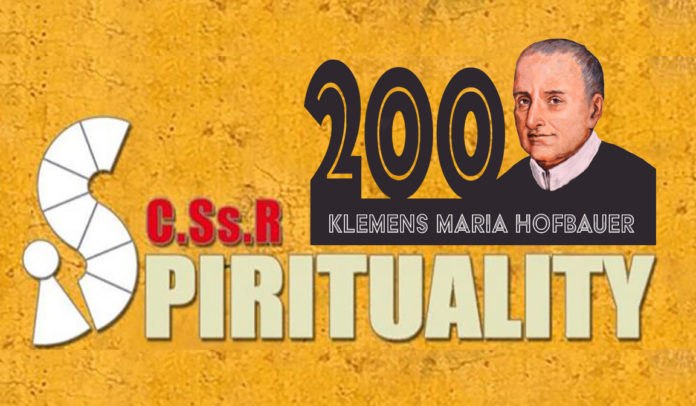In my final year (1964-1965) in the Redemptorist minor seminary of the then-Edmonton Province, our class chose St Clement Hofbauer as our class patron. We had read biographies of the three Redemptorists who had been canonized by that time (Alphonsus, Gerard and Clement). All of us found Clement to be the most sympatico of the three – primarily because he seemed to us to be the most down to earth and practical. The apostolic zeal and creativity of St Clement resonated with us eighteen- and nineteen-year old prospective Redemptorists.
Over the years of my Redemptorist apostolic life, I have come to recognize the source of Hofbauer’s apostolic zeal: his deep and strong Catholic faith, which was rooted in his profound communion with God who is always present and active. In an essay on St Clement, I read that for Clement the world of faith is simply natural and necessary in order to live. All that Clement did is based on the acceptance of God’s will.
It took 34 years before Clements’s interior life, his desire to serve God and the Church, and external circumstances came together so that he could begin to live his vocation as a Redemptorist priest. Much has been written about the time in which St Clement lived, about his life, and about his missionary work and activity; however, I would like to focus more on Hofbauer’s interior life. I have been struck by the longing for solitude that we find throughout the life of this very active, apostolic saint.
It seems timely to consider Clement Hofbauer’s interior life. Pope Francis has called all of us to be missionary disciples, and St Clement is a vivid example with his extraordinary pastoral achievements. But we do well to remember that Clement’s apostolic life was also filled with failure and disappointment. What sustained him through all of that was his interior life.
There are a number of hints and openings in Clement’s life journey that offer glimpses of his inner life.
Death of his father
Clement – the ninth of twelve children – was seven years old when his father died in 1758. An incident which had a profound effect on Clement is recorded in all the biographies. Since it was an intimate moment between mother and son, it can only be known because Clement himself spoke of it; and he spoke of it because it was for him a deep interior, spiritual experience. The day his father died, Clement’s mother brought him before a crucifix, pointed to the image of the Saviour and said: “My child, from now on, this is your father. Be careful to follow the path that pleases him.”
The whole of Clement’s life journey was in fact marked by an unwavering trust in God and the commitment to doing God’s will. His personal relationship with God was at the heart of all he said and did – especially in the face of his many personal and apostolic failures. One of Clement’s sayings that have stayed with me since the first time I read a biography of St Clement is: “Nur Mut! Gott lenkt alles!” (Only courage! God guides everything!)
Life as a hermit
It seems to me the most revealing sign of Hofbauer’s interior life is the eight years (age 25 to 32) when he lived as a hermit. Fabriciano Ferrero corroborates that when he writes: “Among the important factors which influenced Clement’s spiritual formation, the mark of the hermit life seems the clearest.” (Fabriciano Ferrero, “The Significance of Hermitism in the Life and Spirituality of Saint Clement” in Saint Clement Hofbauer: His Writings and Spirituality. Edited by Raymond Corriveau. Liguori Publications, 2008, p 124).
It should be noted that “the hermit life” at the time of Clement was not so austere as that of the Desert Fathers and Mothers. However, the spirit of solitude was still central. Ferrero notes that “the hermit witnessed to the transcendence of God in the midst of a society in profound ideological and cultural transformation.” (Ferrero, Ibid, p 125)
Clement’s life as a hermit had two stages. The first was 1775-1777 at Muelfrauen in his home country, and the second was 1782-1783 at Tivoli, outside Rome. (The time in between was a most important period of ongoing discernment about his vocation, while he worked as a baker and made many pilgrimages, especially to Rome.)
The witnesses in Hofbauer’s beatification process cite his love of solitude and the difficulties in continuing his studies for the priesthood as factors in his decision to “live in isolation completely united with God and so serve him.”
Clement’s hermit time in Tivoli seems to have been especially important in the development of his spirituality. Throughout his life as a Redemptorist, he felt a certain nostalgia for his time there. When he spoke of Tivoli, he often repeated, “There one could really pray.”
In Tivoli, Clement came to the conclusion that to be a hermit was not his vocation, and he returned to Vienna to continue his studies, with a view to ordination as a priest. Dissatisfied with the theology being taught there, Clement and his close friend Thaddeus Huebl left Vienna and set off for Rome where they both joined the Congregation of the Most Holy Redeemer.
Back in central Europe
After being ordained Redemptorist priests, Clement and Thaddeus were commissioned to return across the Alps to establish the Congregation outside of Italy. First in Warsaw (St Benno’s) and then in Vienna we see the fruit of Hofbauer’s time of solitude, prayer and reflection as a hermit. The way in which Clement adapted the Redemptorist charism to the different circumstances in each of those two cities is nothing short of amazing. His deep Catholic faith, his creativity and his dogged perseverance made for an extraordinary life of pastoral and apostolic work.
Ferrero comments that Clement’s time as a hermit helped him to make the transition ‘from a world of the past…become inculturated little by little and with all simplicity, in the new world of the Enlightenment, of Romanticism and of the Revolutions. This transition was such that he is one who plays a lead role in the Christian renewal of central Europe.” (Ferrero, Ibid, p 119) And Ferrero concludes: “St Clement never forgot the light of Tivoli. Because of it, he became the missionary-prophet in a way that was almost co-natural to him.” (Ferrero, Ibid, p 125)
One of Clement’s close friends in Vienna corroborates Ferrero’s conclusion:
Father Hofbauer led a very active life in Vienna….He had only one room which was open to all….There he created in his heart a desert, a lonely cell, a small oratory. Into this loneliness of the heart…he would withdraw whenever he wanted to, at any time, wherever he found himself, even when he wandered through the most crowded streets, he immersed himself in himself.
Father Srna knew Clement well, because for years he lived with him in very close quarters. He claimed that Hofbauer was a great man of prayer “because prayer was the nourishment and refreshment of his heart.” (Josef Heinzmann, Preaching the Gospel Anew: Saint Clement Maria Hofbauer. Liguori Publications, 1998, p 178)
Conclusion
A maxim attributed to St Clement Maria Hofbauer might sum up his interior life: “The best means for becoming holy is to sink oneself into the divine will like a stone into a sea and to let oneself be rolled and tossed around at will.” That is still a challenge for contemporary members of the Redemptorist Family. Let us sink into the divine will!
Reflection Questions
1. With the scene of the seven-year-old Clement and his mother before the crucifix in mind: Have you ever had a similar experience?
2. “Among the important factors which influenced Clement’s spiritual formation, the mark of the hermit life seems the clearest.” What role has solitude played in your formation and your life?
Prayer of Saint Clement Hofbauer
It is enough to have courage.
O, God you are the master.
You guide all for the sake of your glory
and for what is best for us,
and no one can resist you.
All our plans, however well thought out,
serve only to fulfill your will.
Amen.
—————————————————————————————————–
 ONE BODY is a monthly prayer text proposed by the Center for Redemptorist Spirituality.
ONE BODY is a monthly prayer text proposed by the Center for Redemptorist Spirituality.
This text was written by David Louch, CSsR
For more information: Piotr Chyla CSsR (Director of the Center for Spirituality – fr.chyla@gmail.com).
PDF file: One Body – July ENG






